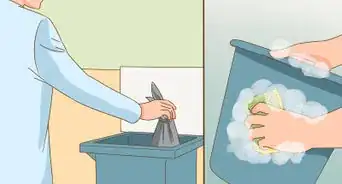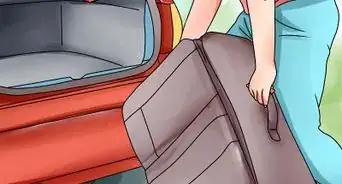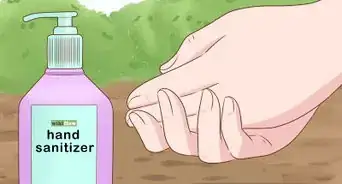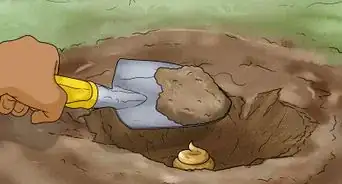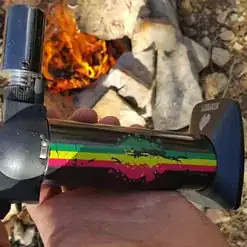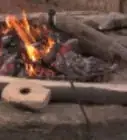This article was co-authored by Britt Edelen and by wikiHow staff writer, Dan Hickey. Britt Edelen was an active member of his local Boy Scouts troop near Athens, Georgia from ages 8 to 16. As a Scout, he went on dozens of camping trips, learned and practiced many wilderness survival skills, and spent countless hours appreciating the great outdoors. In addition, Britt worked as a counselor for several summers at an adventure camp in his hometown, which allowed him to share his passion for and knowledge of the outdoors with others.
There are 8 references cited in this article, which can be found at the bottom of the page.
wikiHow marks an article as reader-approved once it receives enough positive feedback. In this case, several readers have written to tell us that this article was helpful to them, earning it our reader-approved status.
This article has been viewed 419,035 times.
Summertime isn’t complete without a good ole campfire, but how do you build one? Starting a campfire at a campground or in backcountry is a breeze once you know which sticks to grab and how to arrange them. That’s why we’ve put together a step-by-step guide to safely and successfully building your own friendly campfire. Keep scrolling so you can get to those roasted marshmallows and campfire songs!
Steps
Expert Q&A
-
QuestionHow do you put out a campfire without water?
 Britt EdelenBritt Edelen was an active member of his local Boy Scouts troop near Athens, Georgia from ages 8 to 16. As a Scout, he went on dozens of camping trips, learned and practiced many wilderness survival skills, and spent countless hours appreciating the great outdoors. In addition, Britt worked as a counselor for several summers at an adventure camp in his hometown, which allowed him to share his passion for and knowledge of the outdoors with others.
Britt EdelenBritt Edelen was an active member of his local Boy Scouts troop near Athens, Georgia from ages 8 to 16. As a Scout, he went on dozens of camping trips, learned and practiced many wilderness survival skills, and spent countless hours appreciating the great outdoors. In addition, Britt worked as a counselor for several summers at an adventure camp in his hometown, which allowed him to share his passion for and knowledge of the outdoors with others.
Outdoor Educator If you don't have water, you can use dirt. Just make sure you're using a lot of dirt to snuff out any oxygen. Sand is another good option, so long as you make sure the fire is extinguished and not just covered by the sand.
If you don't have water, you can use dirt. Just make sure you're using a lot of dirt to snuff out any oxygen. Sand is another good option, so long as you make sure the fire is extinguished and not just covered by the sand. -
QuestionHow much kindling would I need to keep a fire going all night?
 Britt EdelenBritt Edelen was an active member of his local Boy Scouts troop near Athens, Georgia from ages 8 to 16. As a Scout, he went on dozens of camping trips, learned and practiced many wilderness survival skills, and spent countless hours appreciating the great outdoors. In addition, Britt worked as a counselor for several summers at an adventure camp in his hometown, which allowed him to share his passion for and knowledge of the outdoors with others.
Britt EdelenBritt Edelen was an active member of his local Boy Scouts troop near Athens, Georgia from ages 8 to 16. As a Scout, he went on dozens of camping trips, learned and practiced many wilderness survival skills, and spent countless hours appreciating the great outdoors. In addition, Britt worked as a counselor for several summers at an adventure camp in his hometown, which allowed him to share his passion for and knowledge of the outdoors with others.
Outdoor Educator The advice that was always given to me in Boy Scouts was if you need to keep a fire going all night, or for 24 hours, you need a pile of kindling that's the size of a VW Beetle. Then, just to be safe, double it. So basically two cars worth of kindling. That 100% will get you through the night.
The advice that was always given to me in Boy Scouts was if you need to keep a fire going all night, or for 24 hours, you need a pile of kindling that's the size of a VW Beetle. Then, just to be safe, double it. So basically two cars worth of kindling. That 100% will get you through the night. -
QuestionWhat size sticks should I use for a campfire?
 Britt EdelenBritt Edelen was an active member of his local Boy Scouts troop near Athens, Georgia from ages 8 to 16. As a Scout, he went on dozens of camping trips, learned and practiced many wilderness survival skills, and spent countless hours appreciating the great outdoors. In addition, Britt worked as a counselor for several summers at an adventure camp in his hometown, which allowed him to share his passion for and knowledge of the outdoors with others.
Britt EdelenBritt Edelen was an active member of his local Boy Scouts troop near Athens, Georgia from ages 8 to 16. As a Scout, he went on dozens of camping trips, learned and practiced many wilderness survival skills, and spent countless hours appreciating the great outdoors. In addition, Britt worked as a counselor for several summers at an adventure camp in his hometown, which allowed him to share his passion for and knowledge of the outdoors with others.
Outdoor Educator It depends on the size of the fire. You can't just continue putting big sticks on a small fire because that will suffocate it. To maintain size and maintain safety, you'll want to use smaller sticks when the fire is smaller and then add bigger sticks as it grows.
It depends on the size of the fire. You can't just continue putting big sticks on a small fire because that will suffocate it. To maintain size and maintain safety, you'll want to use smaller sticks when the fire is smaller and then add bigger sticks as it grows.
References
- ↑ https://www.fs.usda.gov/detail/modoc/home/?cid=stelprdb5313899
- ↑ https://www.trespass.com/advice/how-to-make-a-campfire/
- ↑ https://www.fs.usda.gov/detail/modoc/home/?cid=stelprdb5313899
- ↑ https://www.iowadnr.gov/About-DNR/DNR-News-Releases/ArticleID/356/How-to-Build-a-Campfire-Tutorial
- ↑ https://www.iowadnr.gov/About-DNR/DNR-News-Releases/ArticleID/356/How-to-Build-a-Campfire-Tutorial
- ↑ https://www.trespass.com/advice/how-to-make-a-campfire/
- ↑ https://www.gvsu.edu/rec/outdoors/leave-no-trace-68.htm
- ↑ https://www.iowadnr.gov/About-DNR/DNR-News-Releases/ArticleID/356/How-to-Build-a-Campfire-Tutorial
- ↑ https://www.gvsu.edu/rec/outdoors/leave-no-trace-68.htm
- ↑ https://www.discovery.com/exploration/how-to-build-the-7-different-campfires-you-ll-need-this-summer
- ↑ https://www.iowadnr.gov/About-DNR/DNR-News-Releases/ArticleID/356/How-to-Build-a-Campfire-Tutorial
- ↑ https://www.nps.gov/articles/campfires.htm
- ↑ https://www.nps.gov/articles/campfires.htm
- ↑ https://www.fs.usda.gov/detail/okawen/alerts-notices/?cid=fsbdev3_053601
- ↑ https://www.gvsu.edu/rec/outdoors/leave-no-trace-68.htm
- ↑ https://www.gvsu.edu/rec/outdoors/leave-no-trace-68.htm
- ↑ https://modernsurvivalblog.com/survival-skills/wet-fire-wood-how-to-start-a-fire/
About This Article
To build a campfire, start by digging a shallow pit and clearing out any nearby vegetation. Then, put some tinder, like crumpled up paper or wood shavings, in the bottom of the pit. Next, arrange your kindling and firewood around the tinder in a teepee shape. When you're ready to light the fire, hold a lighter underneath the tinder until it catches. Wait for the flames to spread to the kindling and firewood. If they go out before the bigger pieces of wood catch, try adding more tinder and relighting the fire. If you want to learn more, like different shapes that you can build your campfire, keep reading!












